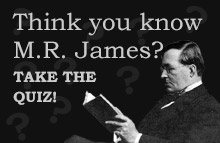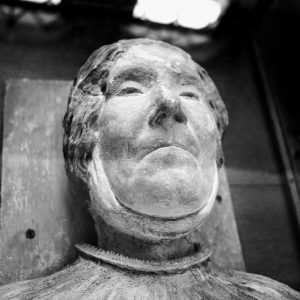 Textaphobes beware! This month Will and Mike tackle Henrietta Dorothy Everett’s “The Death Mask”, a supernatural farce about termagant wives, gold diggin’ husbands and menacing fabrics.
Textaphobes beware! This month Will and Mike tackle Henrietta Dorothy Everett’s “The Death Mask”, a supernatural farce about termagant wives, gold diggin’ husbands and menacing fabrics.
Story notes:
- Monty writes,“Going back a few years I light on Mrs Everett’s The Death Mask, of a rather quieter tone on the whole, but with some excellently conceived stories.” ( Some Remarks on Ghost Stories, The Bookman, 1929). We had our pick of stories from this collection and of course went with the titular (and best) tale.
- Mrs Everett wrote most of her work under the pseudonym of Theo Douglas, though the anthology ‘The Death-mask’ was published under her own name just three years before her death in 1923, aged 72. We struggled to find much about Mrs E. online, but did reconstruct her family tree and found out about the tragic and horribly noteworthy death of her Grandfather’s brother!
- That said, we did find that there is a bundle of papers regarding Mrs Everett’s family, together with that of her husband, at the Naval archives in Greenwich. Material for a potential thesis? We’d love to know more about her.
- There’s a good wikipedia article on the complex set of rules that developed around mourning in the Victorian era. It seems like the mourning expectations for women were more arduous than for men, with women being expected to be in mourning for a husband for 1-4 years, while men got away with mourning for a wife for just 3-5 months! By these standings, Tom has done his fair share.
- The picture above is the death mask of Grace, Lady Manners of Derbyshire, recorded for posterity after her death. Photo credit to David Brierley.

Podcast: Play in new window | Download
Subscribe:

This month Mike and Will throw caution to the wind and make an ill-fated wish on “The Monkey’s Paw” by W.W. Jacobs. Best known in his own time for gentle tales of the sea and other comic stories, Jacobs is now perhaps most famous for this classic cautionary tale of cursed taxidermy, family tragedy and pant-wetting zombie horror. And following the show there’s a bonus fanboy smack-down between Mike and Will, as they try to emulate a listener’s M.R. James game show triumph on TV’s “Mastermind” in 1981. Come for the monkey, stay for the quiz!
Show notes:
- Our amazing reader this month was singer and songwriter Patrick Walker of the band 40 Watt Sun. We hope you enjoy his readings and that he’ll join us again in the future!
- Our picture credit is to artist Noah Weaver. You can find this picture and others at his gallery.
- William Wymark Jacobs (1863–1943) lived through the same period as M.R. James, though we don’t think their paths ever crossed. His story is probably the most famous story we’re covering in this series and there is a wikipedia page dedicated to the many adaptations and spoofs of his plot, including the Simpsons episode Treehouse of Horror II in 1991.
- We drew extensively from M. Grant Kellermeyer’s notes on the story in his excellent edited edition of W.W. Jacob’s stories (available from Oldstyle Tales Press) and the very useful SparkNotes for this story.
- Will enjoyed tracking down the origins of the three wishes plot. Professor D. L. Ashliman’s website has a number of examples, including a NSFW version from ‘The Thousand and One Arabian Nights’ (hint: it’s probably big enough already) and a classic European folk tale of a man who transforms his wife’s nose into a sausage.
- If you’d like to hear from a protagonist who deals with the consequences of being offered three wishes with slightly more sense and wisdom then check out ‘The Third Wish’, a rather touching story by ‘The Wolves of Willoughby Chase’ author Joan Aiken.
- You can hear ‘The Monkey’s Paw’ introduced by author David Mitchell (who calls it ‘one of the most perfect ghost stories ever written’) and then read by Ben Hicks. Mitchell says of the story, “It’s a puzzle, it’s a trap, it’s a dare, it’s a flippant joke from Edwardian England that gets bent out of shape by esoteric India.”
- Head over to Friends of Count Magnus to find out more about the M.R. James conference that is taking place in York later this month – tickets may still be available!
- Finally, listeners from outside of the UK might not know that Mastermind is a famous gameshow here, consisting of a general knowledge round and questions on a topic chosen by each contestant. The life and stories of M.R. James occasionally comes up as specialist subject, including as selected by listener Colin H in 1991 and most recently (we think) by comedian John Finnemore on Celebrity Mastermind in 2016.

Podcast: Play in new window | Download
Subscribe:
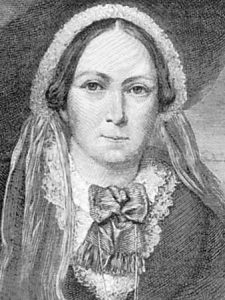 Have you ever had a hankering for upping sticks and moving overseas, where one’s limited means might stretch a little further and the wine flow more freely? This week Will and Mike head for the north coast of France in Featherston’s Story, where Mrs Henry Wood shows us that expat life is not always baguettes, brie and “la bonne vie”…
Have you ever had a hankering for upping sticks and moving overseas, where one’s limited means might stretch a little further and the wine flow more freely? This week Will and Mike head for the north coast of France in Featherston’s Story, where Mrs Henry Wood shows us that expat life is not always baguettes, brie and “la bonne vie”…
Show notes:
- MR James wrote in ‘Some Remarks on Ghost Stories” that “I own to reading not infrequently ‘Featherston’s Story’ in the fifth series of Johnny Ludlow, to delighting in its domestic flavour and finding its ghost very convincing. (Johnny Ludlow, some young persons may not know, is by Mrs Henry Wood)”.
- Mrs Henry Wood (or Ellen) began to published her Johnny Ludlow supernatural tales in 1868. She did so anonymously (or rather under the name ‘Johnny Ludlow’) in ‘The Argosy’, a magazine that she had taken over editorship of the year before. The website mrshenrywood.co.uk is a fantastic resource if you would like to find out more about her prolific writing career.
- Ellen Wood admitted the stories were written by herself in the introduction to the first Johnny Ludlow anthology, published in 1880. She claimed that she wrote them under a pseudonym because using her own name would have destroyed the illusion that they were true accounts of things that happened to the male protagonist.
- The Ludlow stories are quite well known today for their supernatural content, but the paranormal only featured in a small number of the Ludlow stories. These were more commonly crime, adventure or romance stories (of the 80 individually named Ludlow stories, only 17 feature the supernatural). They were packed full of characters, perhaps over a thousand in total.
- Featherston’s Story was published after Ellen Wood’s death and is one of the last of the Johnny Ludlow tales. There’s a full list of Ludlow stories online, with a very brief summary of themes for each.

Podcast: Play in new window | Download
Subscribe:
 Textaphobes beware! This month Will and Mike tackle Henrietta Dorothy Everett’s “The Death Mask”, a supernatural farce about termagant wives, gold diggin’ husbands and menacing fabrics.
Textaphobes beware! This month Will and Mike tackle Henrietta Dorothy Everett’s “The Death Mask”, a supernatural farce about termagant wives, gold diggin’ husbands and menacing fabrics.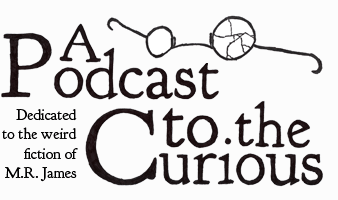
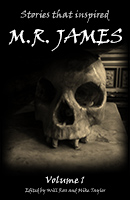


 Have you ever had a hankering for upping sticks and moving overseas, where one’s limited means might stretch a little further and the wine flow more freely? This week Will and Mike head for the north coast of France in Featherston’s Story, where Mrs Henry Wood shows us that expat life is not always baguettes, brie and “la bonne vie”…
Have you ever had a hankering for upping sticks and moving overseas, where one’s limited means might stretch a little further and the wine flow more freely? This week Will and Mike head for the north coast of France in Featherston’s Story, where Mrs Henry Wood shows us that expat life is not always baguettes, brie and “la bonne vie”…



